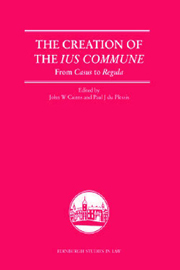Book contents
- Frontmatter
- Contents
- Preface
- List of Contributors
- List of Abbreviations
- Introduction
- 1 The Sources of Medieval Learned Law
- 2 The Infrastructure of the Early Ius Commune: The Formation of Regulae, or its Failure
- 3 Ius Quaerens Intellectum: The Method of the Medieval Civilians
- 4 Medieval Family and Marriage Law: From Actions of Status to Legal Doctrine
- 5 The Roman Concept of Ownership and the Medieval Doctrine of Dominium Utile
- 6 Succession to Fiefs: A Ius Commune Feudorum?
- 7 Towards the Medieval Law of Hypothec
- 8 The Ignorant Seller's Liability for Latent Defects: One Regula or Various Sets of Rules?
- 9 The Glossators' Monetary Law
- 10 Citations and the Construction of Procedural Law in the Ius Commune
- 11 Doctoribus bona dona danda sunt: Actions to Recover Unpaid Legal Fees
- Index
2 - The Infrastructure of the Early Ius Commune: The Formation of Regulae, or its Failure
Published online by Cambridge University Press: 12 September 2012
- Frontmatter
- Contents
- Preface
- List of Contributors
- List of Abbreviations
- Introduction
- 1 The Sources of Medieval Learned Law
- 2 The Infrastructure of the Early Ius Commune: The Formation of Regulae, or its Failure
- 3 Ius Quaerens Intellectum: The Method of the Medieval Civilians
- 4 Medieval Family and Marriage Law: From Actions of Status to Legal Doctrine
- 5 The Roman Concept of Ownership and the Medieval Doctrine of Dominium Utile
- 6 Succession to Fiefs: A Ius Commune Feudorum?
- 7 Towards the Medieval Law of Hypothec
- 8 The Ignorant Seller's Liability for Latent Defects: One Regula or Various Sets of Rules?
- 9 The Glossators' Monetary Law
- 10 Citations and the Construction of Procedural Law in the Ius Commune
- 11 Doctoribus bona dona danda sunt: Actions to Recover Unpaid Legal Fees
- Index
Summary
INTRODUCTION
All interpretative activity necessarily begins with the explanation of words. This is what the medieval jurists first did when they started to explore the corpora of Roman and canon law. Next to this “literal” approach, they soon applied other exegetic methods, such as indicating texts containing identical (similia) or contrary (contraria) solutions to a legal problem or casus. These similia and contraria, originally listed in the margins of the manuscripts at a fixed distance from the main text, presented a challenge to inventive legal minds: was it possible to explain the discrepancies and reduce these to apparent contradictions? The method chosen for this end was usually the distinction (distinctio). Harmony was attained by a reduction of all the relevant texts to a “tree” of casus, of variable complexity, in which all the aspects of a specific subject matter were supposed to have found their place.
An alternative method, also aimed at reduction of the texts pertaining to a specific matter, was to develop a regula or regulae. In this case the stress was less on the analytical process of explaining (apparent) differences, and more on achieving a synthesis that found a rule or rules that connected casus at a higher level. This way it was sometimes possible to create more order in areas of law that had not – or not sufficiently – been the object of this technique of generalisation. There was a title in the Digest on the point (D 50.17), consisting of 211 regulae iuris antiqui (rules of the old law, that is, the law of the so-called classical period).
- Type
- Chapter
- Information
- The Creation of the Ius CommuneFrom Casus to Regula, pp. 57 - 76Publisher: Edinburgh University PressPrint publication year: 2010



